Healthcare Informatics: Exploring Key Discussion Questions
VerifiedAdded on 2019/10/12
|6
|1817
|344
Homework Assignment
AI Summary
This assignment delves into the realm of healthcare informatics, addressing key discussion questions that highlight the integration of computer technology in the healthcare field. It explores the necessity of IT familiarity for healthcare professionals, emphasizing its role in information management across various medical specialties. The assignment defines medical informatics and its subspecialties, such as bioinformatics and nursing informatics, underscoring its interdisciplinary nature and focus on improving all aspects of healthcare. It examines telemedicine, its technologies, and its positive impacts, while also discussing the role of computers in public health, including disease monitoring and simulation. Furthermore, the assignment covers the use of virtual reality in surgical planning and training, advantages of robots in the operating room, and the applications of biotechnology. It also discusses point-of-use dispensing, computers in dental surgery, and expert systems. The assignment provides a comprehensive overview of how technology is transforming healthcare practices, research, and patient care.
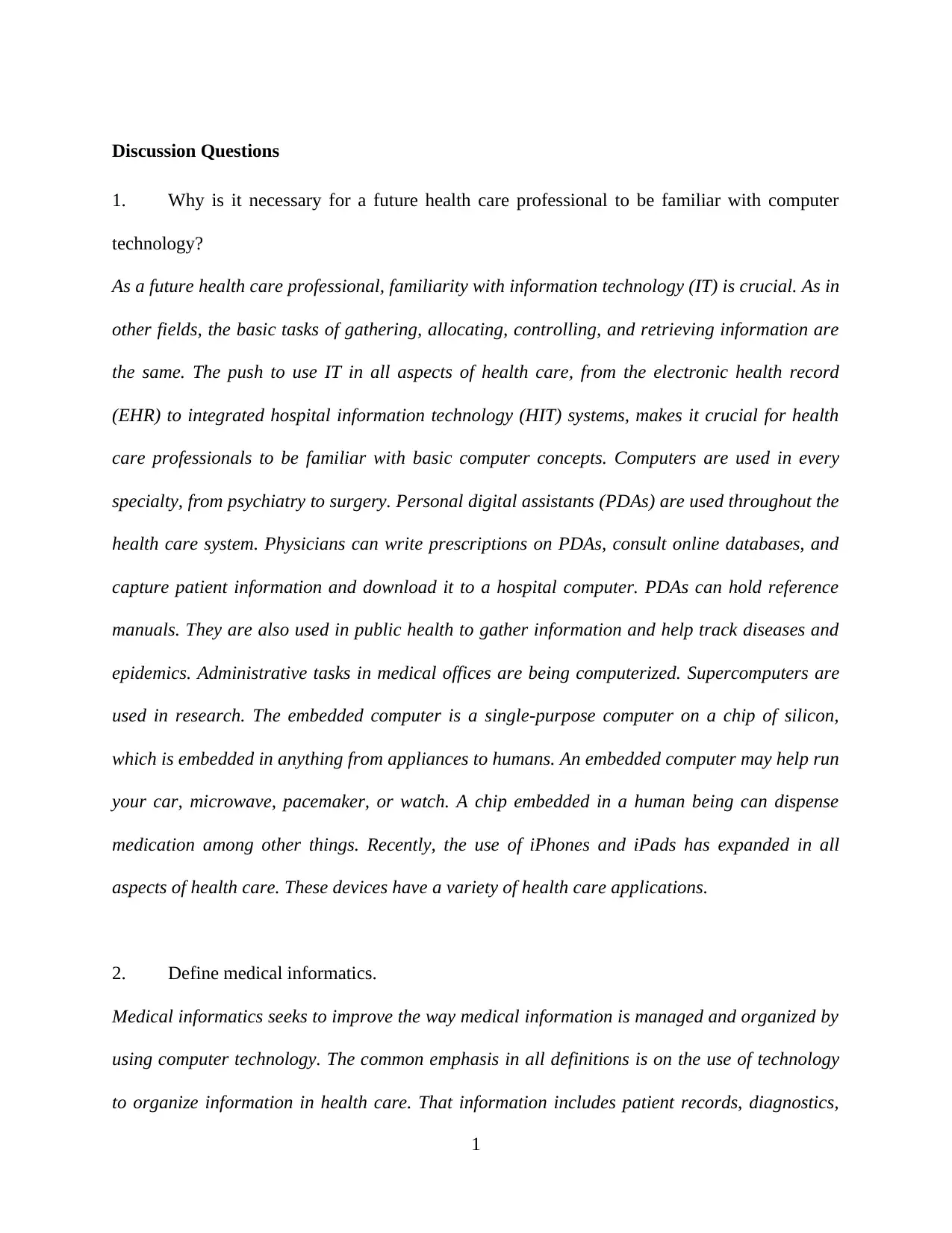
Discussion Questions
1. Why is it necessary for a future health care professional to be familiar with computer
technology?
As a future health care professional, familiarity with information technology (IT) is crucial. As in
other fields, the basic tasks of gathering, allocating, controlling, and retrieving information are
the same. The push to use IT in all aspects of health care, from the electronic health record
(EHR) to integrated hospital information technology (HIT) systems, makes it crucial for health
care professionals to be familiar with basic computer concepts. Computers are used in every
specialty, from psychiatry to surgery. Personal digital assistants (PDAs) are used throughout the
health care system. Physicians can write prescriptions on PDAs, consult online databases, and
capture patient information and download it to a hospital computer. PDAs can hold reference
manuals. They are also used in public health to gather information and help track diseases and
epidemics. Administrative tasks in medical offices are being computerized. Supercomputers are
used in research. The embedded computer is a single-purpose computer on a chip of silicon,
which is embedded in anything from appliances to humans. An embedded computer may help run
your car, microwave, pacemaker, or watch. A chip embedded in a human being can dispense
medication among other things. Recently, the use of iPhones and iPads has expanded in all
aspects of health care. These devices have a variety of health care applications.
2. Define medical informatics.
Medical informatics seeks to improve the way medical information is managed and organized by
using computer technology. The common emphasis in all definitions is on the use of technology
to organize information in health care. That information includes patient records, diagnostics,
1
1. Why is it necessary for a future health care professional to be familiar with computer
technology?
As a future health care professional, familiarity with information technology (IT) is crucial. As in
other fields, the basic tasks of gathering, allocating, controlling, and retrieving information are
the same. The push to use IT in all aspects of health care, from the electronic health record
(EHR) to integrated hospital information technology (HIT) systems, makes it crucial for health
care professionals to be familiar with basic computer concepts. Computers are used in every
specialty, from psychiatry to surgery. Personal digital assistants (PDAs) are used throughout the
health care system. Physicians can write prescriptions on PDAs, consult online databases, and
capture patient information and download it to a hospital computer. PDAs can hold reference
manuals. They are also used in public health to gather information and help track diseases and
epidemics. Administrative tasks in medical offices are being computerized. Supercomputers are
used in research. The embedded computer is a single-purpose computer on a chip of silicon,
which is embedded in anything from appliances to humans. An embedded computer may help run
your car, microwave, pacemaker, or watch. A chip embedded in a human being can dispense
medication among other things. Recently, the use of iPhones and iPads has expanded in all
aspects of health care. These devices have a variety of health care applications.
2. Define medical informatics.
Medical informatics seeks to improve the way medical information is managed and organized by
using computer technology. The common emphasis in all definitions is on the use of technology
to organize information in health care. That information includes patient records, diagnostics,
1
Paraphrase This Document
Need a fresh take? Get an instant paraphrase of this document with our AI Paraphraser
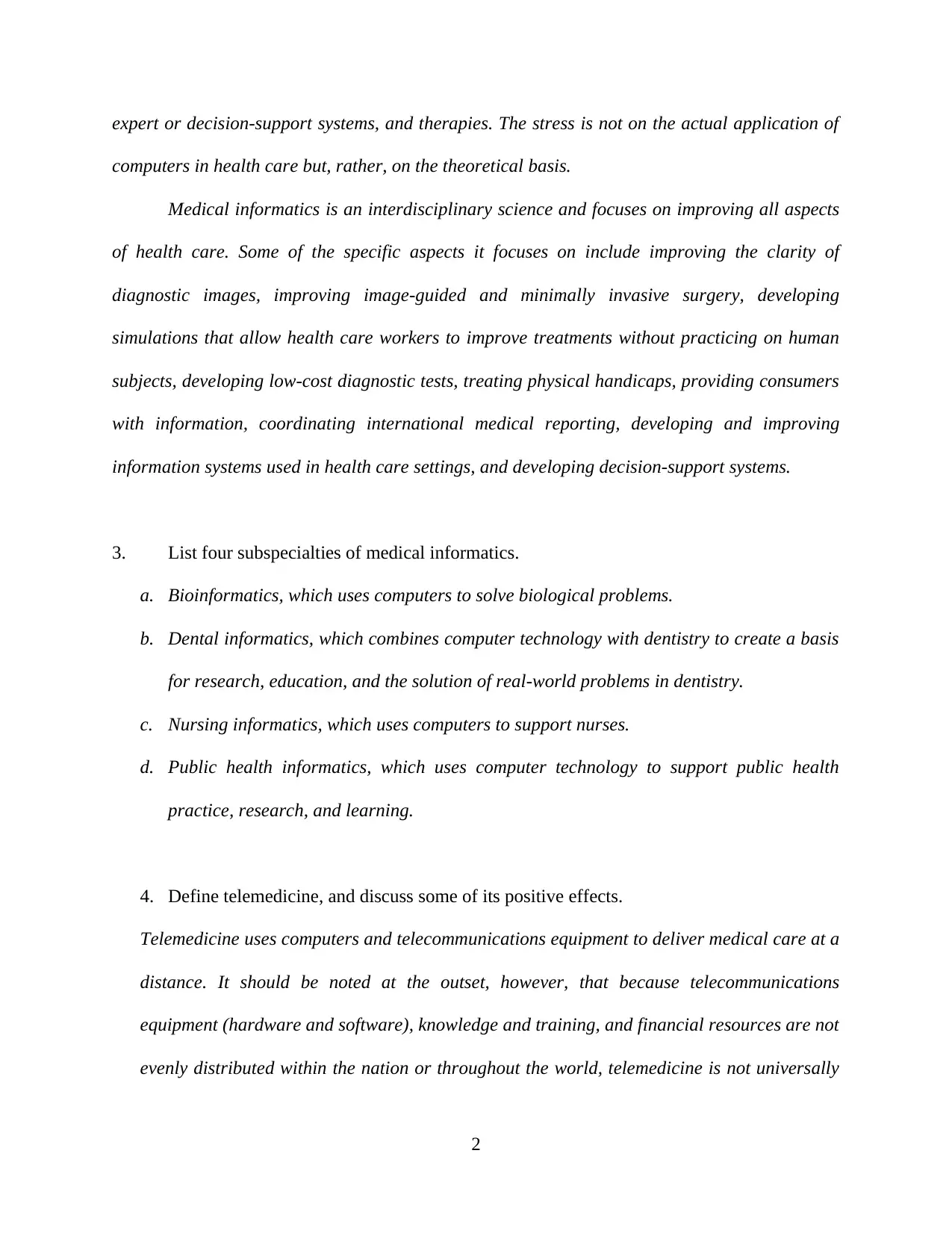
expert or decision-support systems, and therapies. The stress is not on the actual application of
computers in health care but, rather, on the theoretical basis.
Medical informatics is an interdisciplinary science and focuses on improving all aspects
of health care. Some of the specific aspects it focuses on include improving the clarity of
diagnostic images, improving image-guided and minimally invasive surgery, developing
simulations that allow health care workers to improve treatments without practicing on human
subjects, developing low-cost diagnostic tests, treating physical handicaps, providing consumers
with information, coordinating international medical reporting, developing and improving
information systems used in health care settings, and developing decision-support systems.
3. List four subspecialties of medical informatics.
a. Bioinformatics, which uses computers to solve biological problems.
b. Dental informatics, which combines computer technology with dentistry to create a basis
for research, education, and the solution of real-world problems in dentistry.
c. Nursing informatics, which uses computers to support nurses.
d. Public health informatics, which uses computer technology to support public health
practice, research, and learning.
4. Define telemedicine, and discuss some of its positive effects.
Telemedicine uses computers and telecommunications equipment to deliver medical care at a
distance. It should be noted at the outset, however, that because telecommunications
equipment (hardware and software), knowledge and training, and financial resources are not
evenly distributed within the nation or throughout the world, telemedicine is not universally
2
computers in health care but, rather, on the theoretical basis.
Medical informatics is an interdisciplinary science and focuses on improving all aspects
of health care. Some of the specific aspects it focuses on include improving the clarity of
diagnostic images, improving image-guided and minimally invasive surgery, developing
simulations that allow health care workers to improve treatments without practicing on human
subjects, developing low-cost diagnostic tests, treating physical handicaps, providing consumers
with information, coordinating international medical reporting, developing and improving
information systems used in health care settings, and developing decision-support systems.
3. List four subspecialties of medical informatics.
a. Bioinformatics, which uses computers to solve biological problems.
b. Dental informatics, which combines computer technology with dentistry to create a basis
for research, education, and the solution of real-world problems in dentistry.
c. Nursing informatics, which uses computers to support nurses.
d. Public health informatics, which uses computer technology to support public health
practice, research, and learning.
4. Define telemedicine, and discuss some of its positive effects.
Telemedicine uses computers and telecommunications equipment to deliver medical care at a
distance. It should be noted at the outset, however, that because telecommunications
equipment (hardware and software), knowledge and training, and financial resources are not
evenly distributed within the nation or throughout the world, telemedicine is not universally
2
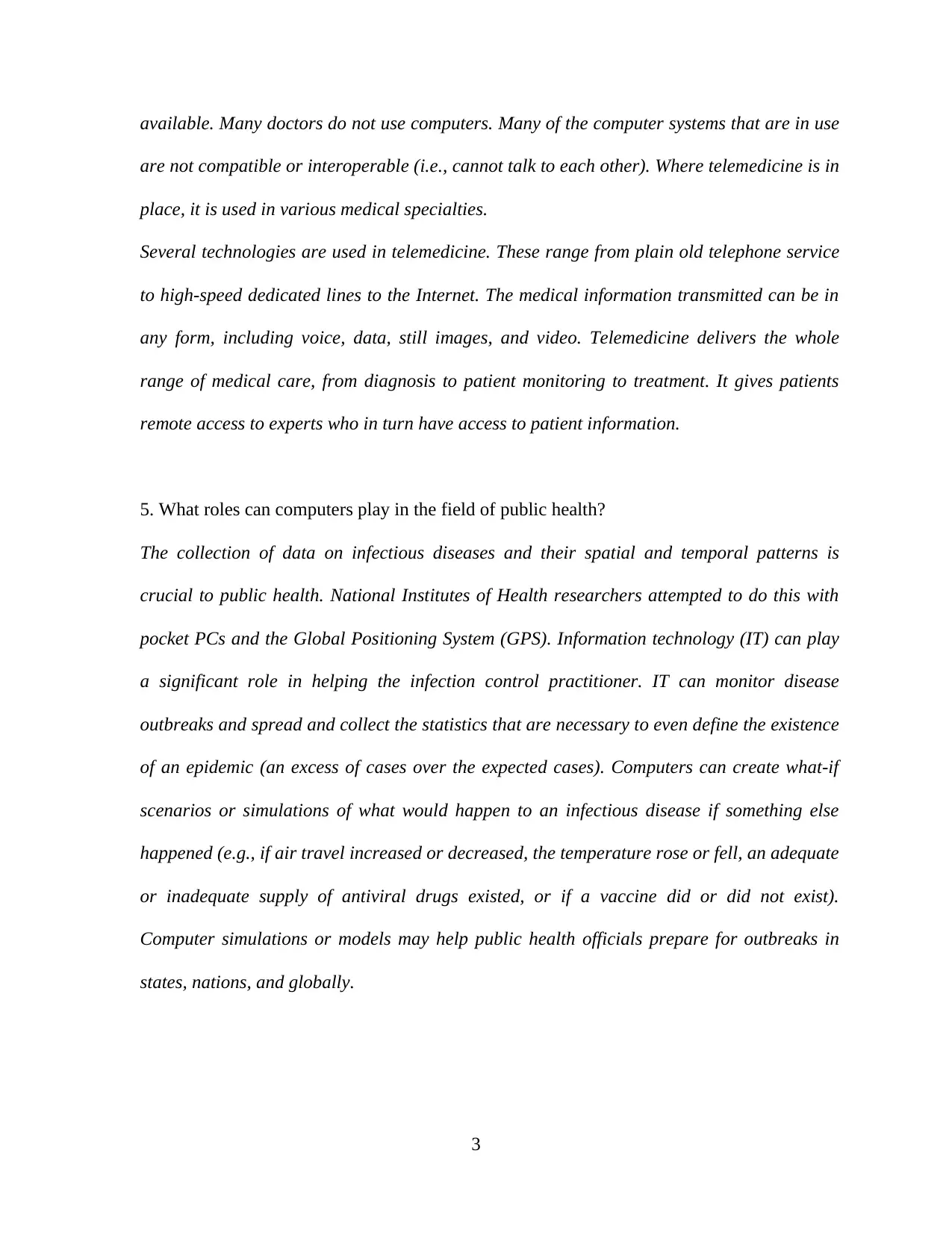
available. Many doctors do not use computers. Many of the computer systems that are in use
are not compatible or interoperable (i.e., cannot talk to each other). Where telemedicine is in
place, it is used in various medical specialties.
Several technologies are used in telemedicine. These range from plain old telephone service
to high-speed dedicated lines to the Internet. The medical information transmitted can be in
any form, including voice, data, still images, and video. Telemedicine delivers the whole
range of medical care, from diagnosis to patient monitoring to treatment. It gives patients
remote access to experts who in turn have access to patient information.
5. What roles can computers play in the field of public health?
The collection of data on infectious diseases and their spatial and temporal patterns is
crucial to public health. National Institutes of Health researchers attempted to do this with
pocket PCs and the Global Positioning System (GPS). Information technology (IT) can play
a significant role in helping the infection control practitioner. IT can monitor disease
outbreaks and spread and collect the statistics that are necessary to even define the existence
of an epidemic (an excess of cases over the expected cases). Computers can create what-if
scenarios or simulations of what would happen to an infectious disease if something else
happened (e.g., if air travel increased or decreased, the temperature rose or fell, an adequate
or inadequate supply of antiviral drugs existed, or if a vaccine did or did not exist).
Computer simulations or models may help public health officials prepare for outbreaks in
states, nations, and globally.
3
are not compatible or interoperable (i.e., cannot talk to each other). Where telemedicine is in
place, it is used in various medical specialties.
Several technologies are used in telemedicine. These range from plain old telephone service
to high-speed dedicated lines to the Internet. The medical information transmitted can be in
any form, including voice, data, still images, and video. Telemedicine delivers the whole
range of medical care, from diagnosis to patient monitoring to treatment. It gives patients
remote access to experts who in turn have access to patient information.
5. What roles can computers play in the field of public health?
The collection of data on infectious diseases and their spatial and temporal patterns is
crucial to public health. National Institutes of Health researchers attempted to do this with
pocket PCs and the Global Positioning System (GPS). Information technology (IT) can play
a significant role in helping the infection control practitioner. IT can monitor disease
outbreaks and spread and collect the statistics that are necessary to even define the existence
of an epidemic (an excess of cases over the expected cases). Computers can create what-if
scenarios or simulations of what would happen to an infectious disease if something else
happened (e.g., if air travel increased or decreased, the temperature rose or fell, an adequate
or inadequate supply of antiviral drugs existed, or if a vaccine did or did not exist).
Computer simulations or models may help public health officials prepare for outbreaks in
states, nations, and globally.
3
⊘ This is a preview!⊘
Do you want full access?
Subscribe today to unlock all pages.

Trusted by 1+ million students worldwide

6. Briefly discuss the use of virtual reality in surgical planning and training.
Computer-assisted surgical planning involves the use of virtual environment technology to
provide surgeons with accurate, realistic models on which to teach surgery and plan and
practice operations. With virtual reality (VR) technology, the computer can create an
environment that seems real but is not. Currently, these lifelike simulations are used in the health
care field. The models created by VR technology can look, sound, and feel real. The models can
respond to pressure by changing shape and to being cut by leaking. A model such as this, which
is interactive, allows surgeons not only to plan surgeries more precisely but also to practice
operations without touching a patient. Some models include a predictive element that shows the
results of the doctor’s actions. For example, plastic surgeons can practice on a model of a face
and see the results of their work.
7. What are some advantages of using robots in the operating room?
Robots, unlike humans, can hold endoscopes and other instruments without becoming tired or
shaky. Robots are also used to scale down the surgeon’s motions. Some surgeons report that this
makes their hands “rock steady,” making surgery on small, delicate areas such as the eye safer.
8. Define and briefly discuss biotechnology.
Biotechnology sees the human body as a collection of molecules and seeks to understand and
treat disease in terms of these molecules. It attempts to identify the molecule causing a problem
and then create another molecule to correct it. Specific drugs are aimed at inhibiting the work of
a specific disease-causing agent. To be effective, the drug needs to bind to its target molecule. It
needs to fit, something like a key in a lock. To achieve an exact fit, the precise structure of the
4
Computer-assisted surgical planning involves the use of virtual environment technology to
provide surgeons with accurate, realistic models on which to teach surgery and plan and
practice operations. With virtual reality (VR) technology, the computer can create an
environment that seems real but is not. Currently, these lifelike simulations are used in the health
care field. The models created by VR technology can look, sound, and feel real. The models can
respond to pressure by changing shape and to being cut by leaking. A model such as this, which
is interactive, allows surgeons not only to plan surgeries more precisely but also to practice
operations without touching a patient. Some models include a predictive element that shows the
results of the doctor’s actions. For example, plastic surgeons can practice on a model of a face
and see the results of their work.
7. What are some advantages of using robots in the operating room?
Robots, unlike humans, can hold endoscopes and other instruments without becoming tired or
shaky. Robots are also used to scale down the surgeon’s motions. Some surgeons report that this
makes their hands “rock steady,” making surgery on small, delicate areas such as the eye safer.
8. Define and briefly discuss biotechnology.
Biotechnology sees the human body as a collection of molecules and seeks to understand and
treat disease in terms of these molecules. It attempts to identify the molecule causing a problem
and then create another molecule to correct it. Specific drugs are aimed at inhibiting the work of
a specific disease-causing agent. To be effective, the drug needs to bind to its target molecule. It
needs to fit, something like a key in a lock. To achieve an exact fit, the precise structure of the
4
Paraphrase This Document
Need a fresh take? Get an instant paraphrase of this document with our AI Paraphraser
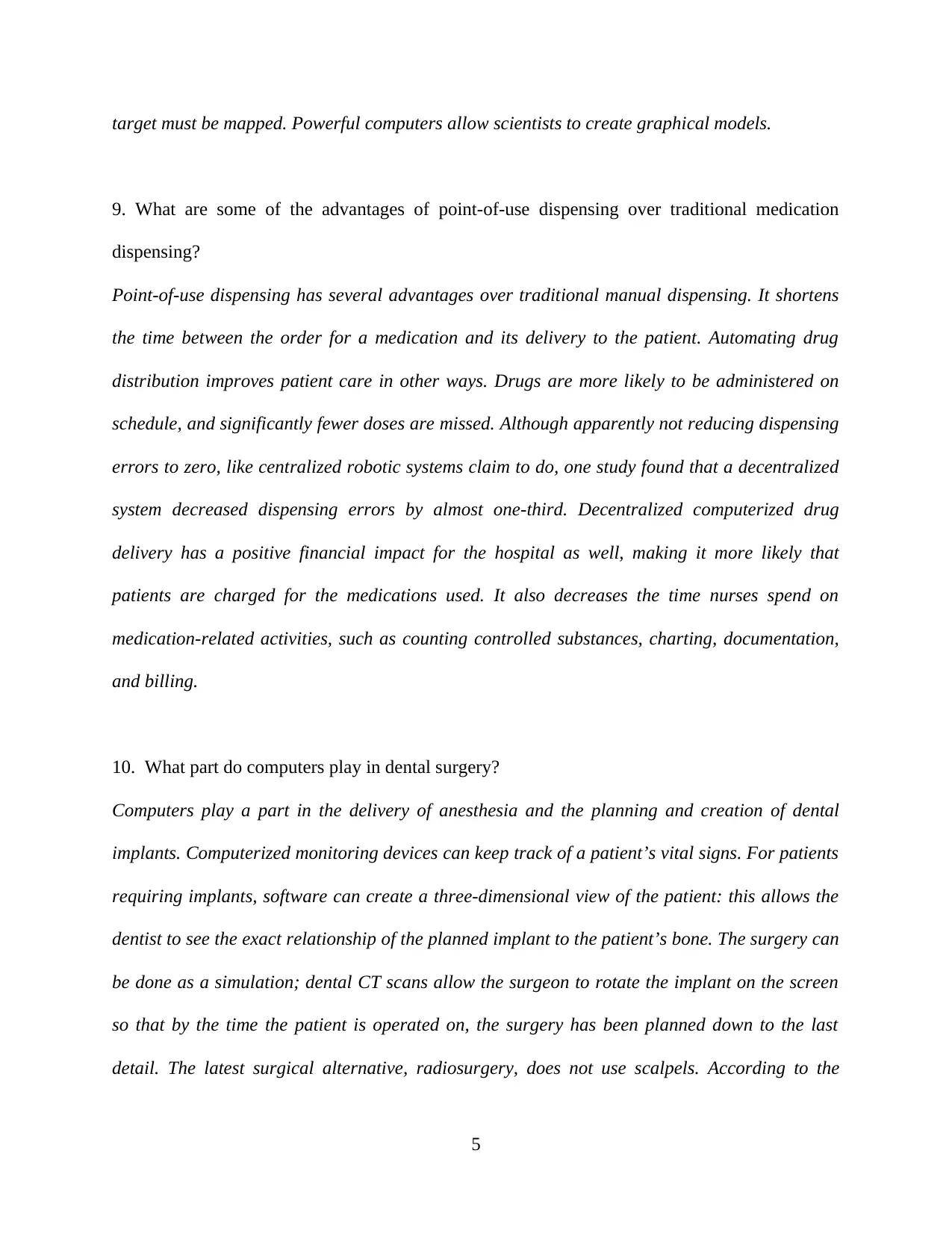
target must be mapped. Powerful computers allow scientists to create graphical models.
9. What are some of the advantages of point-of-use dispensing over traditional medication
dispensing?
Point-of-use dispensing has several advantages over traditional manual dispensing. It shortens
the time between the order for a medication and its delivery to the patient. Automating drug
distribution improves patient care in other ways. Drugs are more likely to be administered on
schedule, and significantly fewer doses are missed. Although apparently not reducing dispensing
errors to zero, like centralized robotic systems claim to do, one study found that a decentralized
system decreased dispensing errors by almost one-third. Decentralized computerized drug
delivery has a positive financial impact for the hospital as well, making it more likely that
patients are charged for the medications used. It also decreases the time nurses spend on
medication-related activities, such as counting controlled substances, charting, documentation,
and billing.
10. What part do computers play in dental surgery?
Computers play a part in the delivery of anesthesia and the planning and creation of dental
implants. Computerized monitoring devices can keep track of a patient’s vital signs. For patients
requiring implants, software can create a three-dimensional view of the patient: this allows the
dentist to see the exact relationship of the planned implant to the patient’s bone. The surgery can
be done as a simulation; dental CT scans allow the surgeon to rotate the implant on the screen
so that by the time the patient is operated on, the surgery has been planned down to the last
detail. The latest surgical alternative, radiosurgery, does not use scalpels. According to the
5
9. What are some of the advantages of point-of-use dispensing over traditional medication
dispensing?
Point-of-use dispensing has several advantages over traditional manual dispensing. It shortens
the time between the order for a medication and its delivery to the patient. Automating drug
distribution improves patient care in other ways. Drugs are more likely to be administered on
schedule, and significantly fewer doses are missed. Although apparently not reducing dispensing
errors to zero, like centralized robotic systems claim to do, one study found that a decentralized
system decreased dispensing errors by almost one-third. Decentralized computerized drug
delivery has a positive financial impact for the hospital as well, making it more likely that
patients are charged for the medications used. It also decreases the time nurses spend on
medication-related activities, such as counting controlled substances, charting, documentation,
and billing.
10. What part do computers play in dental surgery?
Computers play a part in the delivery of anesthesia and the planning and creation of dental
implants. Computerized monitoring devices can keep track of a patient’s vital signs. For patients
requiring implants, software can create a three-dimensional view of the patient: this allows the
dentist to see the exact relationship of the planned implant to the patient’s bone. The surgery can
be done as a simulation; dental CT scans allow the surgeon to rotate the implant on the screen
so that by the time the patient is operated on, the surgery has been planned down to the last
detail. The latest surgical alternative, radiosurgery, does not use scalpels. According to the
5
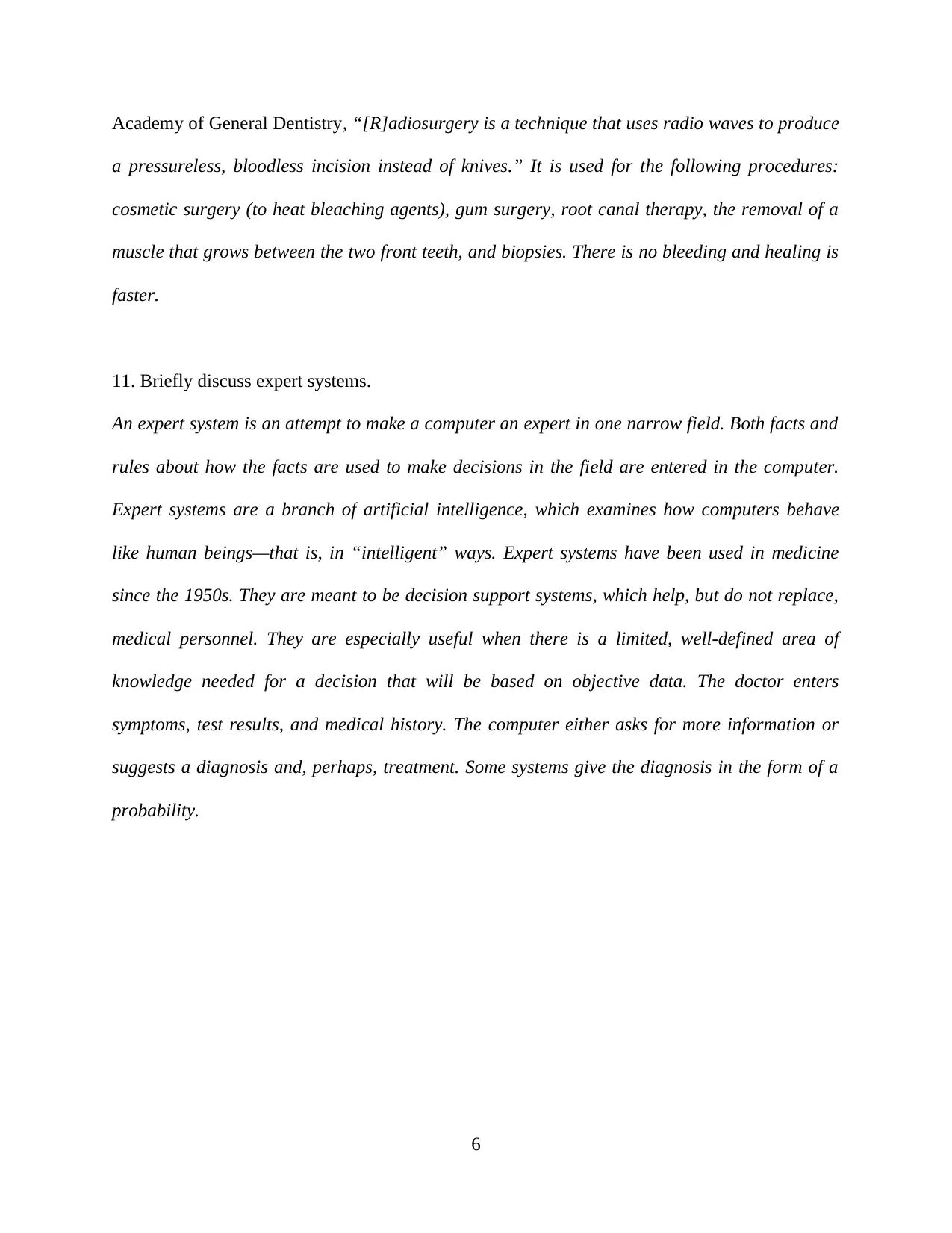
Academy of General Dentistry, “[R]adiosurgery is a technique that uses radio waves to produce
a pressureless, bloodless incision instead of knives.” It is used for the following procedures:
cosmetic surgery (to heat bleaching agents), gum surgery, root canal therapy, the removal of a
muscle that grows between the two front teeth, and biopsies. There is no bleeding and healing is
faster.
11. Briefly discuss expert systems.
An expert system is an attempt to make a computer an expert in one narrow field. Both facts and
rules about how the facts are used to make decisions in the field are entered in the computer.
Expert systems are a branch of artificial intelligence, which examines how computers behave
like human beings—that is, in “intelligent” ways. Expert systems have been used in medicine
since the 1950s. They are meant to be decision support systems, which help, but do not replace,
medical personnel. They are especially useful when there is a limited, well-defined area of
knowledge needed for a decision that will be based on objective data. The doctor enters
symptoms, test results, and medical history. The computer either asks for more information or
suggests a diagnosis and, perhaps, treatment. Some systems give the diagnosis in the form of a
probability.
6
a pressureless, bloodless incision instead of knives.” It is used for the following procedures:
cosmetic surgery (to heat bleaching agents), gum surgery, root canal therapy, the removal of a
muscle that grows between the two front teeth, and biopsies. There is no bleeding and healing is
faster.
11. Briefly discuss expert systems.
An expert system is an attempt to make a computer an expert in one narrow field. Both facts and
rules about how the facts are used to make decisions in the field are entered in the computer.
Expert systems are a branch of artificial intelligence, which examines how computers behave
like human beings—that is, in “intelligent” ways. Expert systems have been used in medicine
since the 1950s. They are meant to be decision support systems, which help, but do not replace,
medical personnel. They are especially useful when there is a limited, well-defined area of
knowledge needed for a decision that will be based on objective data. The doctor enters
symptoms, test results, and medical history. The computer either asks for more information or
suggests a diagnosis and, perhaps, treatment. Some systems give the diagnosis in the form of a
probability.
6
⊘ This is a preview!⊘
Do you want full access?
Subscribe today to unlock all pages.

Trusted by 1+ million students worldwide
1 out of 6
Related Documents
Your All-in-One AI-Powered Toolkit for Academic Success.
+13062052269
info@desklib.com
Available 24*7 on WhatsApp / Email
![[object Object]](/_next/static/media/star-bottom.7253800d.svg)
Unlock your academic potential
Copyright © 2020–2025 A2Z Services. All Rights Reserved. Developed and managed by ZUCOL.




